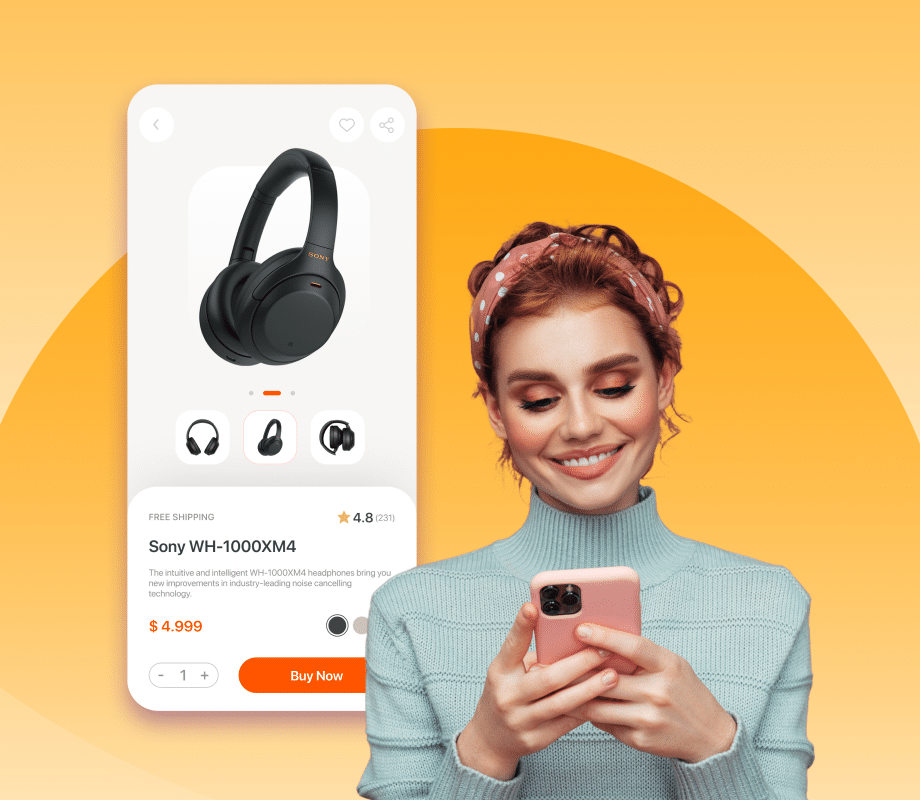Why Triggered Campaigns Matter
In today’s highly competitive marketing landscape, where attention spans are shrinking and customer expectations are skyrocketing, mass promotional emails are no longer effective. Instead, triggered email campaigns automatically sent based on a customer’s behavior or life cycle event have emerged as a high-impact tool for engagement.

According to a 2023 report, triggered emails drive 70.5% higher open rates and 152% higher click-through rates than traditional marketing emails (Campaign Monitor, 2023). 82%[1] of marketers use automation to create triggered emails, which result in 8 times more opens and greater earnings than typical bulk emails.
Yet, many brands continue treating triggered emails as set-and-forget templates. To truly unlock the potential of personalized email marketing, we must rethink these campaigns with dynamic content, real-time personalization, and AI-driven segmentation.
Let’s explore six types of triggered email campaign examples and how you can elevate them using modern personalization techniques.
Types of Triggered Emails
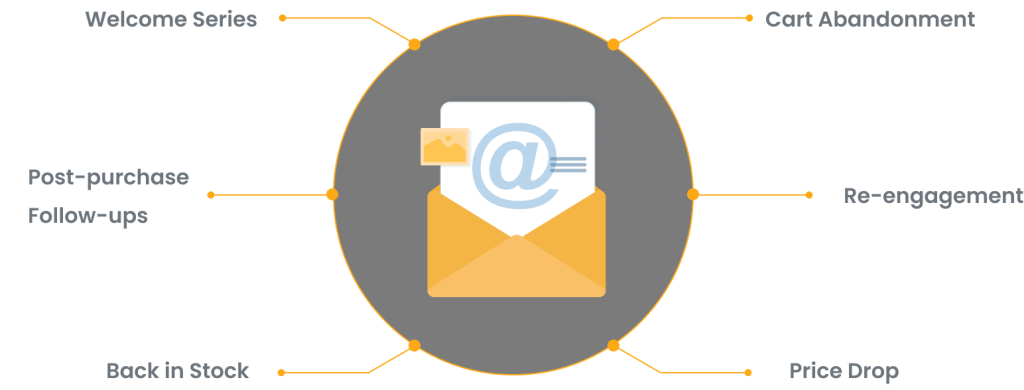
1. Welcome Series: Setting the Stage for Customer Loyalty
Many brands treat welcome emails as a formality, a basic acknowledgment without a real strategy. However, this first impression shapes brand perception by setting the tone for the customer relationship. Research shows that welcome emails generate 320% more revenue per email than other promotional emails.
Welcome Emails vs. Bulk Marketing Emails
Welcome emails have 320% more revenue per email than other promotional emails, as well as:
86% 
lift in unique open rate
196% 
lift in unique click rate
336% 
lift in transaction rate
Elevate Your Strategy:
- Personalize hero banners based on geolocation or browsing data.
- Deliver dynamic content showcasing bestsellers in the customer’s preferred category.
- Embed personalized CTAs leading to curated onboarding journeys.
2. Cart Abandonment Campaigns: Turning Hesitation into Conversion
Cart abandonment costs e-commerce brands an estimated $18 billion[3] in lost revenue annually. While some instances are inevitable, such as distractions or casual browsing, many are opportunities waiting to be reclaimed. Well-crafted cart abandonment emails, boasting an average open rate of 41.18%, are crucial in recapturing these otherwise lost sales.
Left unaddressed, even minor lapses in the post-cart experience can compound over time, impacting revenue and customer loyalty. In an increasingly competitive landscape, brands can no longer afford to treat abandonment as an acceptable cost of doing business.
Elevate Your Strategy:
- Display the abandoned product image dynamically.
- Offer related product recommendations in emails to entice purchases.
- Add social proof (“1200 people bought this last month!”) using real-time personalization.
Algonomy’s Recommend, combined with Ensemble AI, dynamically presents complementary or alternative products based on a shopper’s real-time behavior and preferences.
Rather than simply reminding customers of what they left behind, the system intelligently suggests relevant add-ons or an ensemble to complete their purchase, increasing the likelihood of re-engagement. This personalized product tie-in strategy revives abandoned purchases and boosts average order value, creating a win-win for both the brand and the customer.
Advanced cart abandonment personalization involves not just reminding but inspiring, making alternative offers irresistible, enhancing urgency with live inventory updates, and showing complementary products that fit their taste.
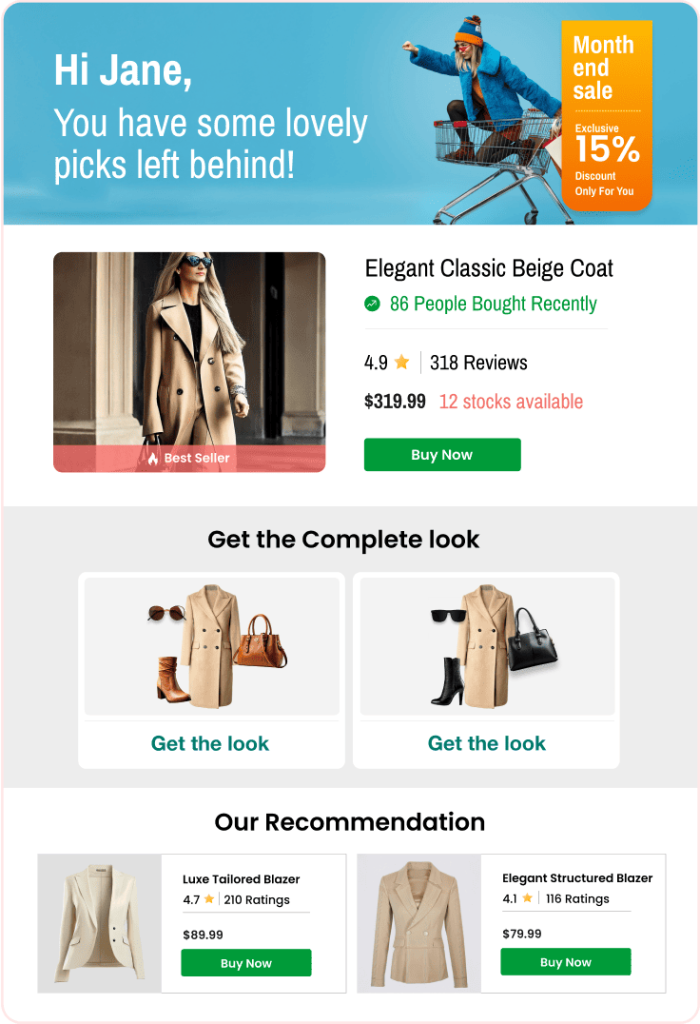
3. Post-Purchase Follow-Ups: Building Relationships Beyond Transactions
Neglecting this critical touchpoint risks losing engaged buyers, while thoughtful post-purchase communication can transform first-time purchasers into long-term brand advocates.Post-purchase is a golden moment to solidify loyalty and boost repeat purchases. Following a robust post-purchase email strategy helps improve customer lifetime value.
Elevate Your Strategy:
- Recommend complementary products based on past purchases and affinity modeling.
- Use replenishment signals from Audience Manager via dynamic content blocks to set up reminders (e.g., for beauty or grocery categories).
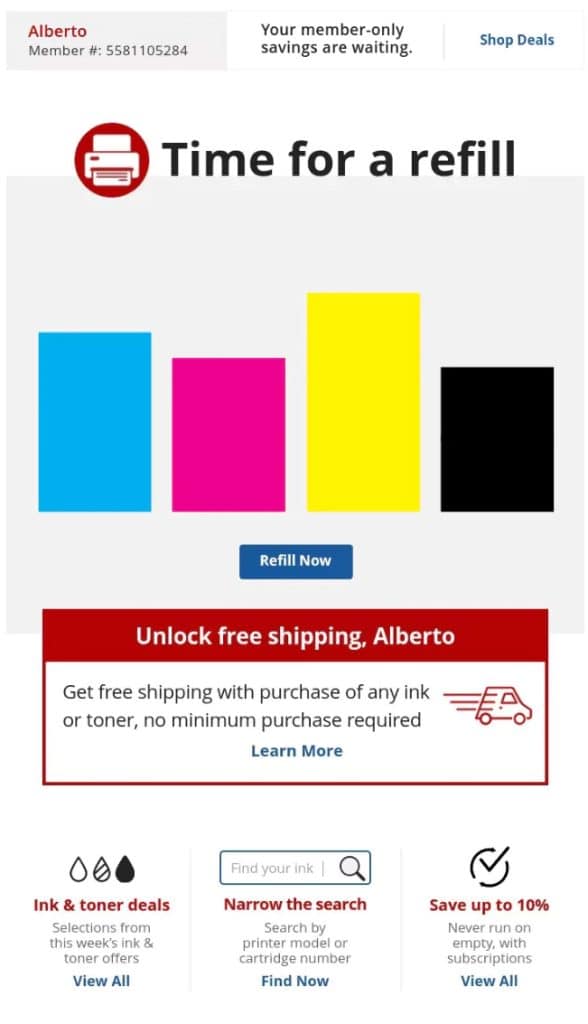
Personalized post-purchase journeys tap into emotional satisfaction. A simple “We thought you might also like” section fueled by AI-powered marketing personalization increases retention.
4. Re-Engagement Campaigns: Winning Back Dormant Customers
Relying solely on generic “We miss you” emails is no longer enough to revive customer relationships. Today’s consumers expect relevant, meaningful engagement that speaks directly to their interests and behaviors. Failing to re-engage dormant customers doesn’t just cost potential sales, it damages long-term brand loyalty.
Recent industry research[4] shows that top-performing marketing teams are over twice as likely to invest in personalized marketing campaigns aimed at bringing back dormant users. Furthermore, the likelihood of selling to an existing customer can be as high as 70%[5], making re-engagement far more cost-effective than acquisition.
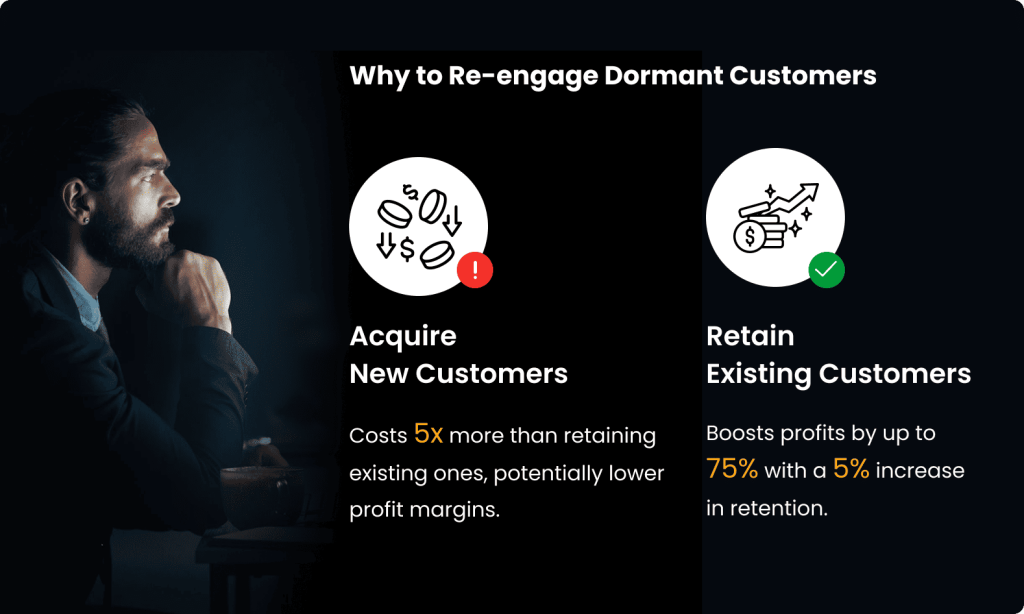
Elevate Your Strategy:
- Use churn propensity scores to create high-risk segments.
- Offer exclusive deals on previously browsed products.
- Personalize messaging with emotional cues (“Still dreaming about that jacket)
For instance:
A customer who bought hiking gear but hasn’t engaged for 60 days gets an email:
“Your Adventure Awaits — Explore New Trails with 20% Off Hiking Boots.”
Using email campaign best practices, retail ensures the tone feels genuine, not robotic.
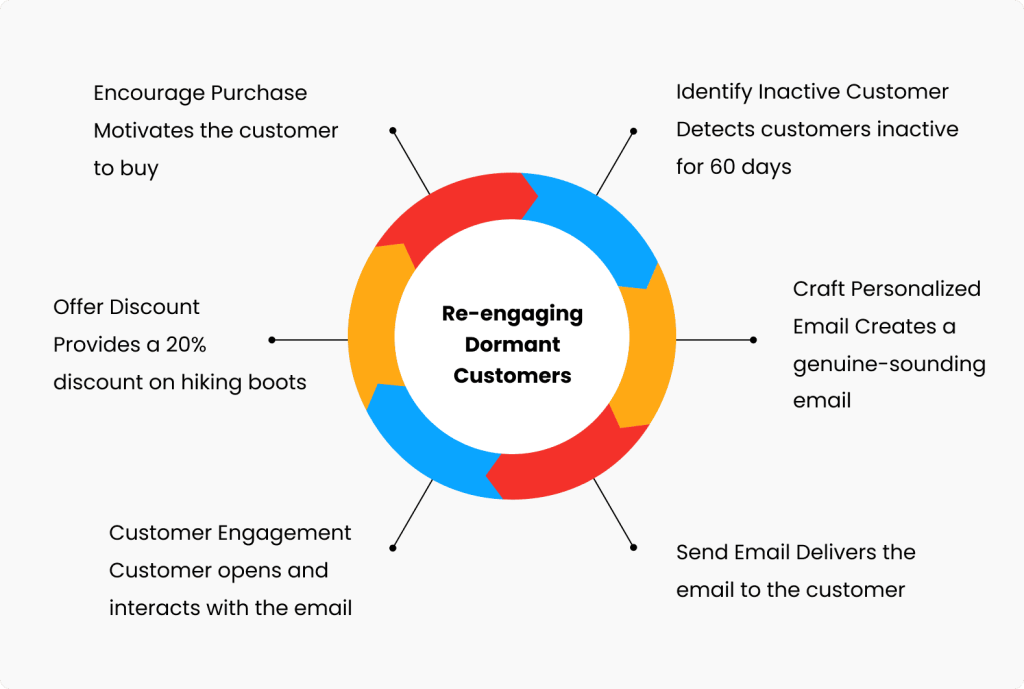
5. Back-in-Stock Alerts: Fueling FOMO with Timing
Nearly two out of every three shoppers will abandon an e-commerce site entirely if a product they intended to buy is unavailable.
2024 AlixPartners Consumer Sentiment Index
When inventory constraints ease, this creates a narrow but powerful window to recapture high-intent interest, a window that’s often missed due to manual workflows or delayed communication.
Well-timed back-in-stock alerts, powered by email personalization, ensure brands convert intent the moment it resurfaces. They signal attentiveness, build emotional connection, and foster a sense of exclusivity; hence, back-in-stock campaigns become not just a tactic but a critical part of the overall customer experience strategy.
Elevate Your Strategy:
- Trigger real-time alerts as soon as products are replenished (using Active Content and Audience Manager integration)
- Segment notifications based on likelihood to convert, prioritizing high-intent customers. (via Audience Manager’s predictive modeling).
- Offer intelligent alternatives when original products are still low in stock.
- Inject urgency indicators like low stock warnings, rising demand tags, or expiring deals.
- Use dynamic countdown timers to create a subtle but effective pressure to act.
For e.g., A customer who wanted a blue denim jacket gets a real-time email:
“It’s Back — Your Favorite Jacket is Here! Sizes Are Selling Fast.”
This personalization approach often achieves 3–5x higher CTRs compared to generic alerts.
Leveraging real-time triggers through email personalization ensures you capitalize on intent the moment it reignites.
6. Price Drop Notifications: Make Savings Personal
Price drop emails are a high-conversion opportunity that taps into existing customer intent, especially for products they’ve previously browsed, wishlisted, or abandoned. These alerts don’t just highlight savings; they create urgency, often prompting immediate action on long-considered purchases. By showcasing recent markdowns, whether as targeted one-offs or in curated batch discount alerts, brands can drive quick wins while reinforcing value. Beyond the sale, these emails make customers feel seen: they show you’re listening, that you understand what matters to them. They’re also highly effective at clearing inventory, surfacing slower-moving products, and reducing dead stock without slashing margins blindly. In today’s price-sensitive market, a well-timed price drop email can turn interest into conversion and consideration into trust.
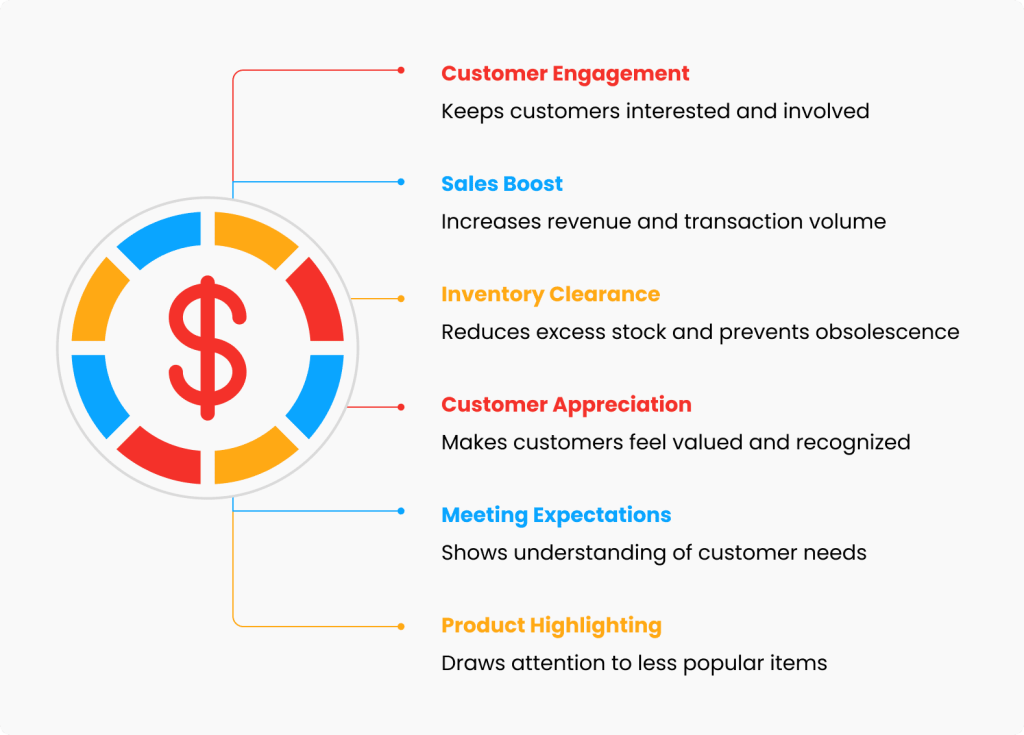
Elevate Your Strategy:
- Target customers based on browsing, abandonment, and wishlist history.
- Segment audiences dynamically using Audience Manager’s product and behavior data.
- Sync real-time inventory to avoid promoting unavailable items.
- Recommend similar products with higher conversion likelihood if stock is limited.
Through dynamic content personalization, price sensitivity is addressed individually, increasing open rates and driving conversions.
Key Takeaways: Scaling Impact with Personalized Email Campaigns
To master modern email marketing and beat inbox fatigue:
01
Prioritize dynamic content personalization in every triggered email.
02
Use behavioral, demographic, and intent signals to segment audiences.
03
Leverage AI-powered marketing personalization to predict next best actions.
04
Follow email campaign best practices, retail, and hyper-personalized messaging wins.
The goal isn’t more email. It’s creating meaningful email that drives connection and revenue.
How Algonomy’s Active Content Helps
Marketers no longer need to choose between creativity and technology. With Active Content, dynamic storytelling can be enhanced by real-time, data-driven personalization. See it in action:
Define Segments Using Audience Manager
Marketers build high-resolution segments using behavioral insights from your recommendation engine, predictive traits (e.g., churn risk), and other attributes like category interest or loyalty status.Sync Segments to Active Content & Marketing Automation Solutions
These audience segments are simultaneously pushed into marketing automation tools for orchestration and Active Content for personalization logic at open time.Build Templates on Active Content’s Digital Canvas
Marketers create templates using Active Content’s Digital Canvas, placing dynamic blocks for product recommendations, offers, loyalty, and other personalized content.Configure Real-time Data Layering
Each dynamic block is wired to multiple live data sources via APIs (e.g., product info, reviews, stock, or offers), enabling rich, layered personalization that marketing platforms can’t support.Trigger Campaigns Via Audience Manager or MA
Journeys initiate when a user qualifies, e.g., cart abandonment, back-in-stock event, or loyalty point threshold, sending the right message to the right person.Personalize Content at the Moment of Email Open
Unlike traditional send-time personalization, Active Content renders the latest data when the email is opened. The same email can look different based on stock, price, or behavior at that moment.Leverage Generative AI for Creative Efficiency
Marketers can auto-generate dynamic headlines, CTAs, or image variations using AI prompts, reducing creative bottlenecks and increasing campaign agility.Control the Final Rendering Experience
Marketers retain full design flexibility over how dynamic content looks, removing the design constraints typically imposed by marketing automation platforms.
Best Practices for Successful Triggered Email Campaigns
To maximize the impact of triggered emails in 2025, marketers must adopt the following best practices:
 Start with Segmentation
Build dynamic segments based on behaviors, demographics, purchase history, and churn risk.
Start with Segmentation
Build dynamic segments based on behaviors, demographics, purchase history, and churn risk. Invest in Real-Time Personalization
Update content at open time, not send time, using dynamic content personalization engines.
Invest in Real-Time Personalization
Update content at open time, not send time, using dynamic content personalization engines.
 Use AI for Predictive PersonalizationPredict next-best actions (buy, browse, churn) and trigger accordingly.
Use AI for Predictive PersonalizationPredict next-best actions (buy, browse, churn) and trigger accordingly. Optimize Send Times
Test and deploy emails at personalized send times using AI recommendations.
Optimize Send Times
Test and deploy emails at personalized send times using AI recommendations.
 Monitor Customer Fatigue
Avoid over-messaging by setting smart frequency caps based on engagement levels.
Monitor Customer Fatigue
Avoid over-messaging by setting smart frequency caps based on engagement levels.
 Test, Learn, Iterate
Run A/B tests on subject lines, dynamic elements, and CTA placements regularly.
Test, Learn, Iterate
Run A/B tests on subject lines, dynamic elements, and CTA placements regularly.
Future of Triggered Emails — Where We Are Headed
As personalization technology evolves, triggered email campaigns will no longer be static workflows but adaptive journeys, powered by real-time signals, predictive analytics, and AI-curated content. With the right triggered campaigns and the right personalization, you don’t just communicate—you convert.
By 2026, Gartner predicts that 70% of brands adopting AI-powered marketing personalization will report a 25% higher marketing ROI (Gartner, 2024[6]).
For marketers willing to invest in email campaign personalization and dynamic content strategies today, the payoff is immense: deeper customer relationships, sustained engagement, and significantly increased revenue.
Ready to transform your triggered campaigns with best-in-class personalization?
Book a Demotoday and explore how Algonomy empowers leading brands to deliver unforgettable customer experiences!
Resources
- https://porchgroupmedia.com/blog/email-marketing-statistics/
- https://www.entrepreneur.com/growing-a-business/how-to-engage-your-email-subscribers-from-the-moment-they/245380
- https://firework.com/blog/cart-abandonment-statistics
- https://www.salesforce.com/resources/research-reports/state-of-marketing/
- https://blog.hubspot.com/marketing/customer-retention-marketing
- https://www.gartner.com/



